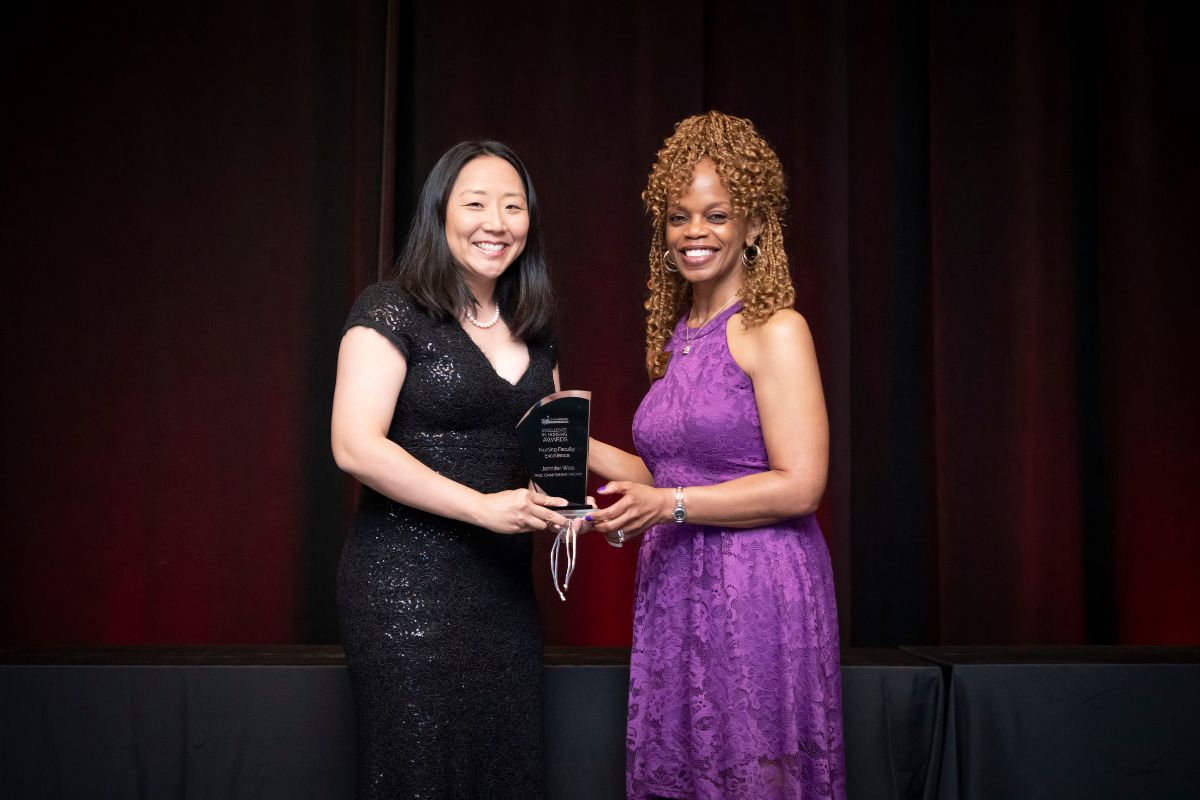Champion for care: UTA’s Woo earns state honor

When it came time to choose the next destination in her career, Jennifer Woo had The University of Texas at Arlington at the top of her list.
She was drawn to UT Arlington’s status as a top-tier research institution—recognized with the prestigious Carnegie R1 designation—and its leadership in addressing the nation’s nursing shortage. UTA is the largest producer of baccalaureate-educated nurses in Texas, having graduated over 10,000 since 2021.
Dr. Woo’s arrival in August 2024 has been a win-win for both her and UTA, where she leads a maternal health nursing lab in the Science and Engineering Innovation and Research (SEIR) building. Over the last decade, she has held positions at major hospitals and universities—experience that has strengthened the College of Nursing and Health Innovation. On June 6, at the Texas Nurses Foundation Excellence in Nursing Gala in Austin, she was honored with the 2025 Nursing Faculty Excellence Award.

“It came as a bit of a surprise, but a pleasant one,” Woo said. “We need more nurses, and we really need passionate faculty who want to invest in students in a holistic way.”
Related: UTA takes lead with mobile lab to address rural health care crisis
Woo recently sat down to share her journey into teaching and what drives her work.
You’re now inspiring the next generation of nurses. Who inspired you?
When I was a student at the University of Pennsylvania, I met Sister Teresita Hinnegan, a nun who taught in the nurse midwifery program. She was such an influential figure in my life—so passionate about midwifery. She served for years as a nurse midwife in Africa. Sister Teresita planted that seed in me. I didn’t think I’d become a midwife—I actually thought I’d go into pediatrics—but I fell in love with midwifery. The continuity of care with patients and families as it relates to prenatal care and women’s health is so special.
What drew you into the teaching side of nursing?
I knew I wanted to go back to school and get my Ph.D. I worked as a full-time nurse and midwife at a federally qualified health center in Chicago, and I saw firsthand the health disparities in maternal outcomes. I knew I wanted to be involved in research and in educating the next generation of nurses.
How would you describe your teaching philosophy?
One of the pillars and foundations of nursing is the art of caring. If we as faculty can train a generation of nurses who are passionate about caring for people, that’s the heart of what we do. It’s about how we advocate for our patients and how we collaborate—bringing in social work, medicine, pastoral care—to truly meet the needs of those we serve. That philosophy applies whether you're a nurse at the bedside, an advanced practice nurse in the clinic, or a researcher. That caring lens should shape our work as nurses.

What is the focus of your research at UTA?
My lab is called BIOMO, which stands for Biosocial Impact for Optimizing Maternal Outcomes. My research has both a clinical component and a wet lab component based at the Bone-Muscle Research Center. Our students aren’t just nursing students, either; some are in public health, bioengineering, kinesiology. It’s been humbling to witness the richness of interdisciplinary work. Our nursing students bring a unique clinical perspective, while our science students bring different strengths. And they all have personal stories that drew them to the lab—someone they know had a preterm birth or preeclampsia or a baby in the NICU. That’s been really meaningful to me.
Since joining UTA, what has stood out most to you?
The sheer volume of nurses we’re graduating is phenomenal—not just undergrads but also advanced practice nurses. I mostly teach in our graduate program, but my lab does give me that one-on-one teaching experience with undergrads. Overall, I’ve just been really impressed with the scale and the quality of our program. In addition, the impactful and innovative research that is happening here at UTA. Having my lab in the SEIR building allows for close collaboration with computer science, biology, kinesiology, public health and more. This really enhances what we can do as a university when we collaborate with multiple disciplines to address the complex and challenging landscape of health care.
About The University of Texas at Arlington (UTA)
Celebrating its 130th anniversary in 2025, The University of Texas at Arlington is a growing public research university in the heart of the thriving Dallas-Fort Worth metroplex. With a student body of over 41,000, UTA is the second-largest institution in the University of Texas System, offering more than 180 undergraduate and graduate degree programs. Recognized as a Carnegie R-1 university, UTA stands among the nation’s top 5% of institutions for research activity. UTA and its 280,000 alumni generate an annual economic impact of $28.8 billion for the state. The University has received the Innovation and Economic Prosperity designation from the Association of Public and Land Grant Universities and has earned recognition for its focus on student access and success, considered key drivers to economic growth and social progress for North Texas and beyond.